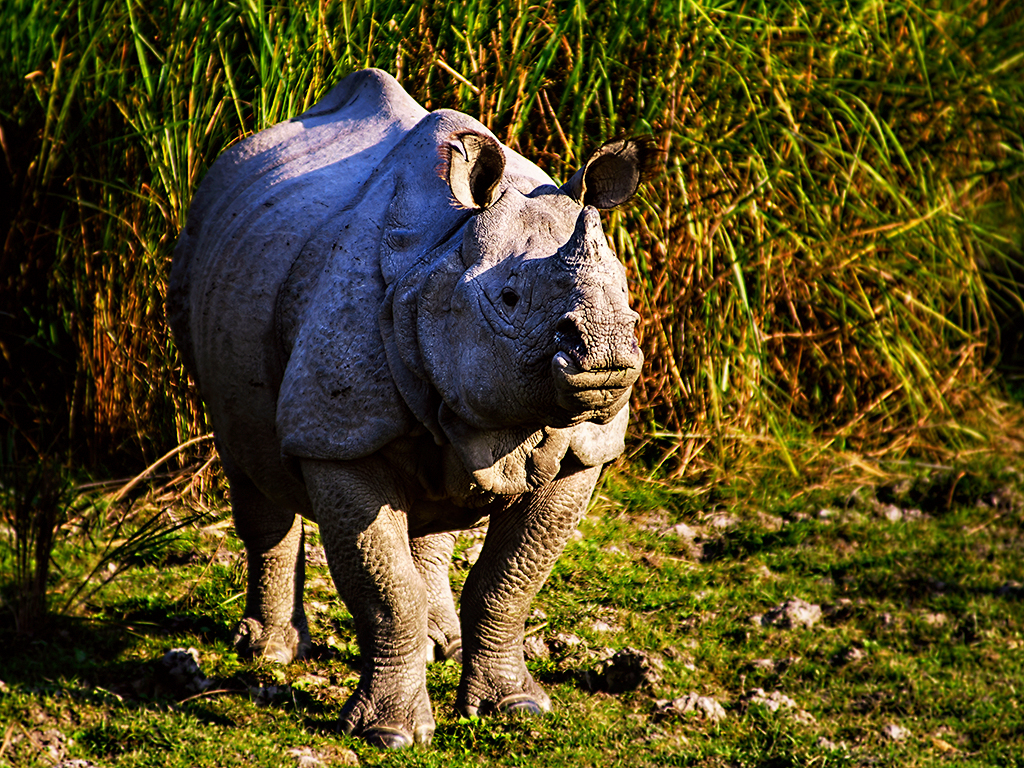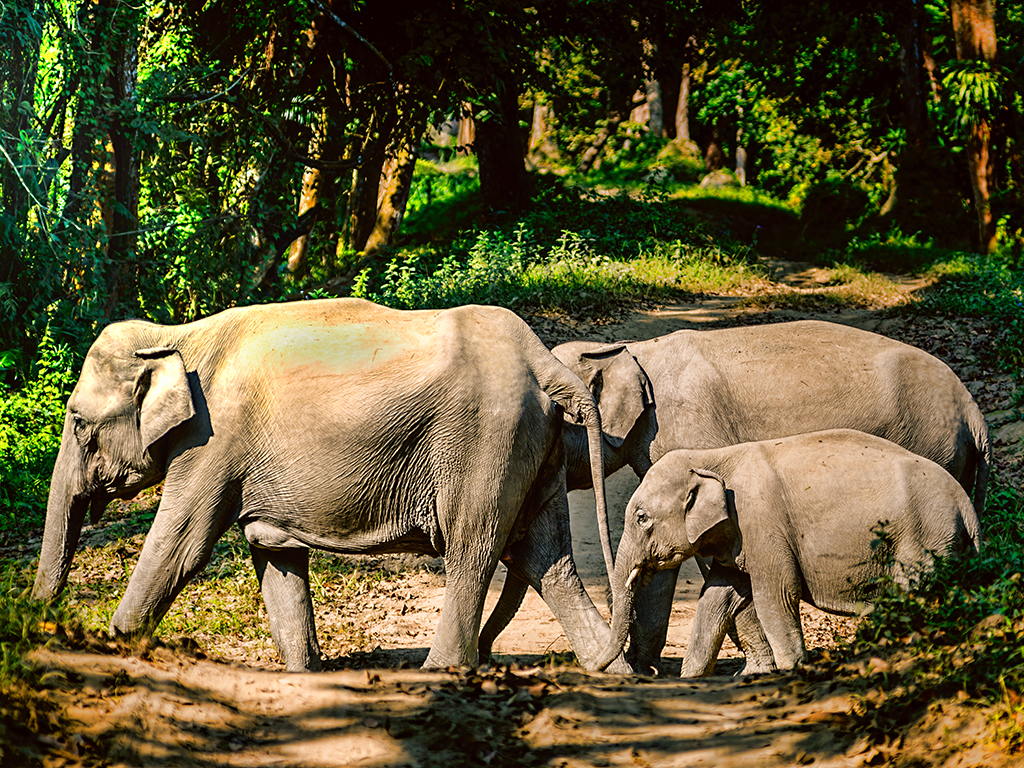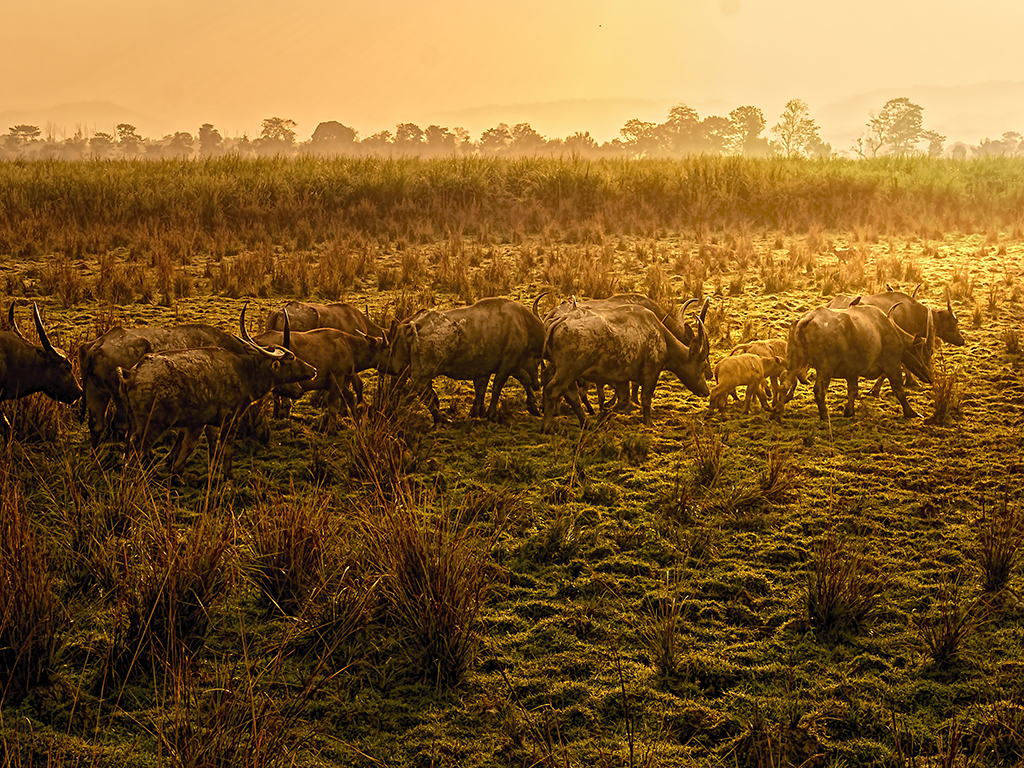The Rhino Pit
The silence of the forest is broken by frightened snorts and grunts of a large animal that has fallen into a trapping pit dug by poachers on a path often used by rhinos. The gang, hiding nearby by a water body called a Beel, comes to investigate. In the light of torches they carry, they gleefully verify that this is indeed a prized catch, the Asian Single Horned Rhino, with its horn intact.
The leader jumps down into the pit on the agitated animal’s back carrying a sharp, curved cleaver called a Dao. The rhino is already injured by its fall and there is no space around for it to shake off the attacker. The poacher raises the cleaver and hacks at the horn….
The next morning, when circling vultures alert the guards of Kaziranga forest that an animal has been killed the night before, it is far too late. The rhino is dead and the poachers long gone with their bloody prize.

How Kaziranga came into being
Rhinos roamed the Indian jungles as long ago as 5000 years when the ancient civilizations of Mohen-Jo- Daro and Harrappa flourished in the Indus valley. Even 300 years ago, rhinos were plentiful over a broad swathe of land that stretched from Iran all the way to Thailand.
Since those days however, hunting for sport and for their horns, wrongly believed to have powerful medicinal properties, has driven the Asiatic one horned rhino to virtual extinction. Things are better today. The animals of Kaziranga National Park are well protected and policed although poaching has not stopped altogether.
In 1904, a visit by Baroness Curzon, wife of the Governor General of British India changed things for this region. She travelled all the way to the jungle of Kaziranga in Assam because she had heard of these legendary armor plated behemoths and wanted to see them with her own eyes. In spite of being guided by the legendary tracker of Assam Balaram Hazarika, all she got to see were hoof marks and droppings. Disappointed, she returned to the capital and impressed upon her husband the urgent need for protecting these vanishing creatures.
As a result, the Kaziranga reserve forest was created in 1905. By 1974, the government of Assam had granted National Park status to Kaziranga so that the forest and its inhabitants may be protected from poaching, encroachments or dangers of flooding.
Kaziranga Habitats
Kaziranga has three distinct types of habitats. The shrubs and tall trees suit the large denizens such as the Elephant, the Rhino and the Wild Buffalo. Tall Elephant grass provide perfect cover for the smaller animals such as the small Barking deer and the larger Hog Deer as well as for wild Hogs. There are several water bodies or Beels scattered around the park. They are used by all animals as watering holes. Birds, both local and migratory, crowd around the Beels.

Three Forest Trails
Visitors may take open jeep safaris along all three forest trails. Elephant safaris are arranged along only the central Kohora Range.
Baghori the Western Range
This circuit, is known for elephant sightings. Near its strategic watchtower, herds of elephants graze within clear view. From this watchtower before sunset, one may see swamp deer, hog deer, buffaloes, rhinos and wild elephants.
Kohora the Central Range
The Kohra Range is the longest of the three, and a 3 to 4 hour safari in this range provides a taste of the entire forest. One may see rhinos, elephants and wild buffaloes. A couple of huge Ficus trees when with fruit, may have pied hornbills feeding on them. Owls, serpents and fishing eagles are seen here, monitor lizards blend into tree trunks, and sometimes elephants and rhinos lurk in the tall grass. Turtles sun themselves on branches sticking out of the water. The large Beels may have Greylag geese feeding, or rhinos wallowing in the water. Domesticated elephants are bathed in the nearby stream in the afternoons.

Agaratoli the Eastern Range
This is the easternmost of the three routes, 21 kilometers from Kohora Base. This range is more wooded than the other two and animal sightings are therefore less frequent. Birds, however, are abundant. there is a pelican colony near the end of the circuit. Forest guards report tiger sightings here more often than in the other ranges.
Tiger Attack!
Although tiger sightings are rarer in Kaziranga that in other tiger reserves of India, one of the most dramatic story of tiger attack has been videotaped near the Eastern Range. In June 2004, a tigress with her two cubs strayed into a village just outside the National Park and attacked cattle. Forest ranger teams set out on elephant back to tranquilize the tigress and her cubs. The tigress was sighted and a tranquilizer dart fired. The dart missed and the enraged tigress jumped almost 12 feet in the air to severely injure the elephant driver or Mahout. She then disappeared into the thick forest, never to be seen again. The video went viral on the Internet!
A Question for You
As we leave Kaziranga behind, let us ponder upon the origin of its name, Kaziranga. The scholars have it that the name derives from a lady tribal leader named Ranga who ruled in this area long before the reserve forest was created. The simple folks however remembered fondly a tragic love story between two young people of different tribes, a youth named Kazi and a maiden named Ranga. Now, which story would you choose?
–
by Jayant Neogy. A student of photography. My best picture is yet to be taken!
Lovely photographs and a delightful narrative.